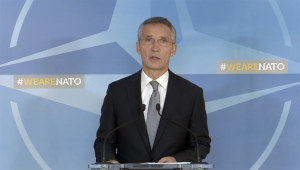nsnbc : NATO Secretary-General Jens Stoltenberg told reporters that he expects the 28 NATO defense ministers’ meeting in the Belgian capital Brussels on November 8 – 9 to agree on an outline for a revision of the alliance command structure.
 Stoltenberg explained that this will include a new command to “help protect sea lines of communication” across the Atlantic between North America and Europe, and another command to “improve the movement of troops and equipment within Europe.”
Stoltenberg explained that this will include a new command to “help protect sea lines of communication” across the Atlantic between North America and Europe, and another command to “improve the movement of troops and equipment within Europe.”
NATO significantly cut troops under direct NATO command from 20,000 personnel in 32 commands at the end of the so-called cold war, to the current 7,000 in seven structures.
Renewed tensions between Russia and the Alliance following the crisis in Ukraine and direct and indirect military involvement in the conflict in Ukraine’s rebelling Donbass region, as well as Russia’s annexation of Crimea, or Crimea’s accession into the Russian Federation as Moscow interprets it, as well as developments other former Soviet Satellite states and parts of the Middle East have prompted both Russia and its (CSTO) allies as well as NATO to rethink their current postures and deterrent as well as operational capabilities.
A series of potentially dangerous close encounters between Russian and NATO warplanes and navy ships in recent years and months has added to the tension between Moscow and the Alliance, leading to mutual accusations and even more aggressive posturing on both sides. NATO members have, among others, accused Russia’s air forces to fly above the Baltic Sea and in some cases airspace above NATO member countries with their transponder turned off.
nsnbc international has in several of these cases requested from relevant Russian and for example Danish and Swedish authorities that they release radar data and other relevant information to the press to substantiate allegations and accusations. All sides have responded kindly but ultimately not released anything, so the outcome for nsnbc was ultimately nothing but phone bills and the ability to report that all sides are as tight-lipped when it comes to evidence as they are grandstanding and posturing.
Developments have prompted Russia and Belarus to hold the Zapad 2017 military exercise clearly showing that the drills are aimed to prepare for offensive and defensive hybrid warfare at the borders to the Alliance. Russia is also about to strengthen its armored capabilities including new tanks, its air defense capabilities with the new S-500 surface to air missile system that has a nuclear option, and air forces in the western district, in cooperation with Belarus.
Developments have prompted NATO to step up its offensive and defensive capabilities in the east, deploying four multinational battlegroups in the three Baltic states and Poland, totaling approximately 4,500 troops. Stoltenberg said that adapting NATO’s command structure was necessary “when tensions are increasing again.”
“We have to be able to move forces, troops, across the Atlantic, from North America to Europe,” Stoltenberg said. “Our ability to move forces is essential to deterrence and collective defense.” Stoltenberg said that no decisions have been taken yet on where the new command bases would be located.
He added that the next meeting of NATO defense ministers in February would be crucial for agreeing more of the details of the revised NATO command structure, which also includes developing means to respond to cyberthreats following a series of global cyberattacks that disrupted multinational firms, ports, and public services this year. Members of the alliance last year recognized cyberspace as a domain of operations in which NATO must defend itself as effectively as it does in the air, on land, and at sea.
Meanwhile, the U.S. ambassador to NATO, Kay Bailey Hutchison, told reporters that NATO allies “saw the need to have more deterrence against the Russian encroachment on the east after Crimea.”
CH/L – nsnbc 08.11.2017
Source Article from https://nsnbc.me/2017/11/08/87007/
Related posts:
Views: 0
 RSS Feed
RSS Feed

















 November 8th, 2017
November 8th, 2017  Awake Goy
Awake Goy 










 Posted in
Posted in  Tags:
Tags: 
















